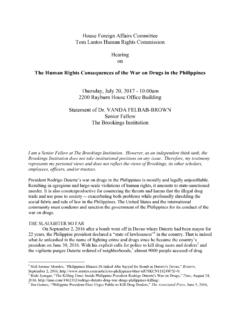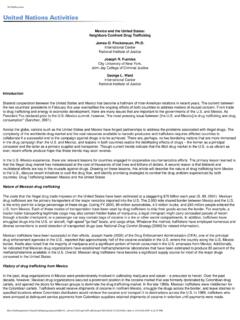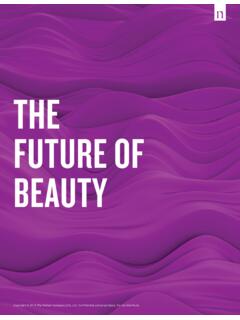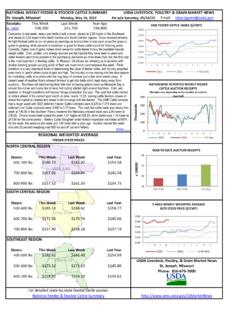Transcription of The Coffee Bean: A Value Chain and Sustainability ...
1 The Coffee Bean: A Value Chain and Sustainability Initiatives Analysis Melissa Murphy, University of Connecticut, Stamford CT USA Timothy J. Dowding, University of Connecticut, Stamford CT USA ABSTRACT This paper examines Starbucks corporate strategy of sustainable efforts in Ethiopia, particularly in the sustainable sourcing Arabica Coffee . The paper discusses the Value Chain of Coffee , issues surrounding the Coffee supply Chain and the need for sustainable Coffee production. In addition it also discusses Starbucks position and influence on the Coffee trade, and the measures that Starbucks is taking to ensure Sustainability efforts throughout the Coffee supply Chain .
2 Coffee Value Chain & P3G ANALYSIS Coffee is produced in more than fifty developing countries in Latin America, Africa, and Asia and it is an important source of income for 20-25 million families worldwide [1]. The initial production of Coffee beans including farming, collecting, and processing is labor intensive and as a result is performed in more labor abundant developing countries. The roasting and branding of Coffee is more capital intensive and therefore is situated in northern industrialized countries. The top five Coffee consumers are United States of America, Brazil, Germany, Japan, and France [1].
3 The structure of the Value Chain is very similar regardless of producing or consuming country. The Coffee Value Chain is made up of the four main phases: Cultivation, Processing, Roasting, and Consumption. Each phase in the process has environmental, social, economic and governance issues that affect the future Sustainability of extracting the Coffee bean. FIGURE 1: THE Coffee Value Chain Cultivation The Coffee cultivation process begins with a Coffee cherry. Coffee cherries are differentiated by type and natural conditions such as altitude, latitude, and volcanic soil.
4 A Coffee plant usually starts to produce flowers 3 4 years after it is planted, and it is from these flowers that Coffee cherries appear, with the first useful harvest possible around 5 years after planting. Cherries typically ripen and are harvested around eight months after the emergence of the flower. In most countries, Coffee cherries are picked by hand which is a very labor intensive and difficult process. After about twenty years the Coffee tree s productivity diminishes, however with correct handling trees can bear cherries for more than fifty years.
5 There are two types of Coffee beans: Robusta and Arabica. Robusta Coffee has a harsher taste, twice the caffeine content, can be grown at sea level, and is more resistant to pests and diseases than Arabica. Arabica Coffee is known for its higher quality, but can only be produced in warmer temperate zones or in highlands of tropical zones and has a shorter ripening period of about six months [2]. The inputs needed to maximize the Coffee cultivation process are fertilizer and pesticides. The outputs from Coffee cultivation are emissions including nitrogen, phosphorous, and pesticide [3].
6 Processing Once Coffee berries are collected they are then transported to processing mills. Cost for transportation from the field to the mill can be significant depending on the distance between the farm and the producing mill. Once the berries arrive at the mill they are processed, sorted, and graded by size, weight, and form. Processing of Coffee is the method of converting the raw fruit of the Coffee cherry into the green (dried) Coffee beans. There are two processing methods: wet and dry process.
7 The wet process requires a lot of effort, time, water, and therefore money. The Coffee cherries are sorted by immersion in water; bad or unripe cherries float and the good ripe cherries sink. The ripe cherries are then machine cleaned by pressing the fruit in water through a screen. Lastly, the beans are OutputExportCultivationRobusta or Arabica cherries( Coffee Farm)ProcessingDry/Wet(Factory)Transport RoastingBlendingGrindingCoolingProducing CountryCultivation/ProcessingFertilizer, Pesticides, Fuel Oil, WaterEmissions: Nitrogen, Phosphorous, and PesticideWaste: Outer hull, dust, scraps from cleaning Coffee bean, wastewaterPackagingRoasting/PackagingCon suming Country Factory or Coffee HouseGreen Coffee , Electricity, Natural Gas, Packing MaterialsInputInputOutputRoast Coffee in Packaging (aluminum cans, paper filters).
8 Emissions:Carbon Monoxide and Carbon dioxide; Waste: Coffee Chaff from roastingTransport to Final Point of SaleConsumptionConsuming Country Coffee Shop or HomeRoasted Ground Coffee , Coffee Filter, Electricity, WaterInputOutputWaste: Coffee Grinds, Coffee Filter, Packaging MaterialsCoffee BrewingPurchase of Roasted Ground Coffee by End UserDisposalMarketingdried either by the sun or by machines. The dry process involves sorting and cleaning cherries by hand and then placing them in the sun to dry naturally or using a machine to speed up the drying process.
9 This is very common on small or medium plantations and in regions where temperatures are warmer and supplies of clean, fresh, water are not plentiful [2]. Inputs needed for the processing phase are the Coffee cherries, water (for the wet processing method), and fuel oil for machine drying. The output of the processing phase are green (dried) Coffee beans and solid waste including the outer hull, dust, and scraps from cleaning the cherries which are typically disposed [3]. The green beans are then classified, graded, and exported to the consuming country for roasting and packaging.
10 CULTIVATION / PROCESSING IMPACTS ON P3G ELEMENTS Because both cultivation and processing take place in the producing country, the impacts these phases have on most of the P3G elements are similar. Issues relating to people, profit, and governance are the same for both cultivation and processing; however each phase has an independent impact on the planet. People In most Coffee producing countries harvesting and processing laborers work under extremely poor conditions. On the farms, Coffee laborers are involved with every aspect of the growing/harvesting process.







